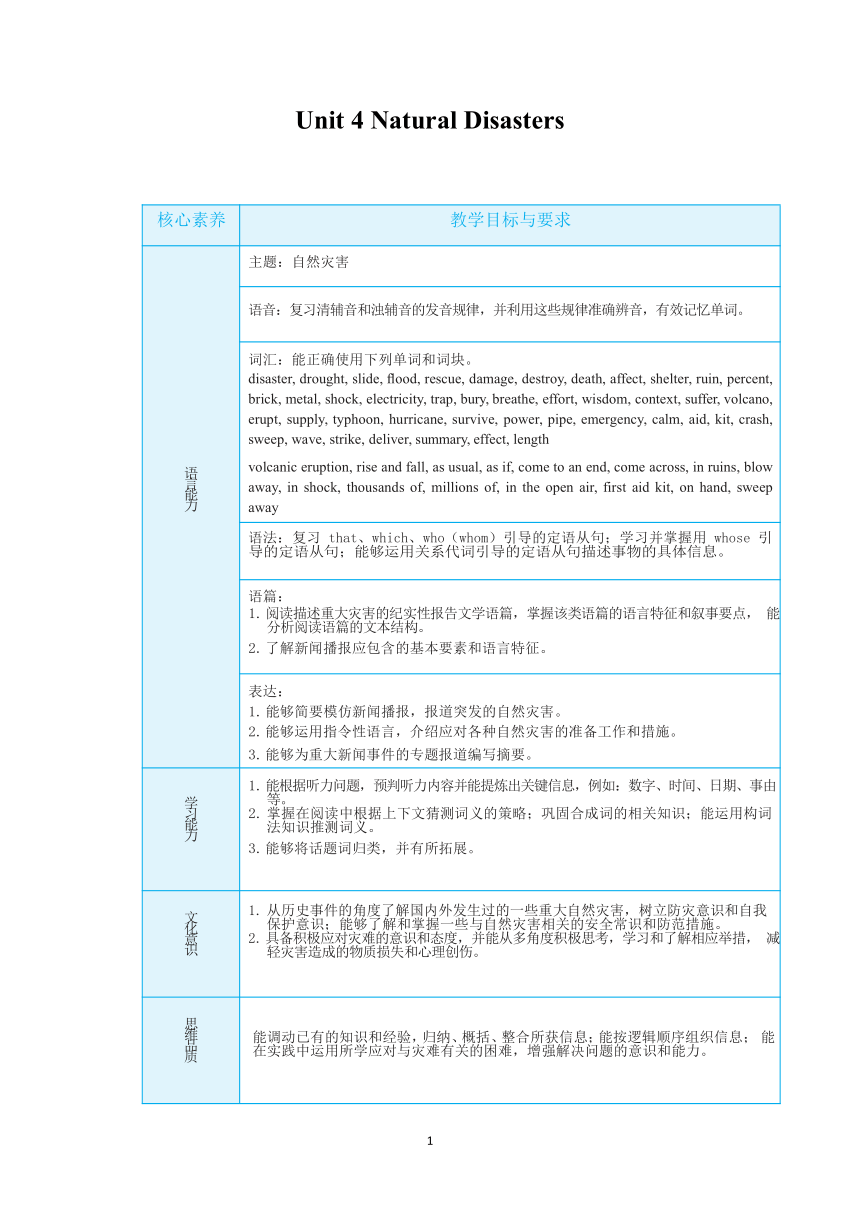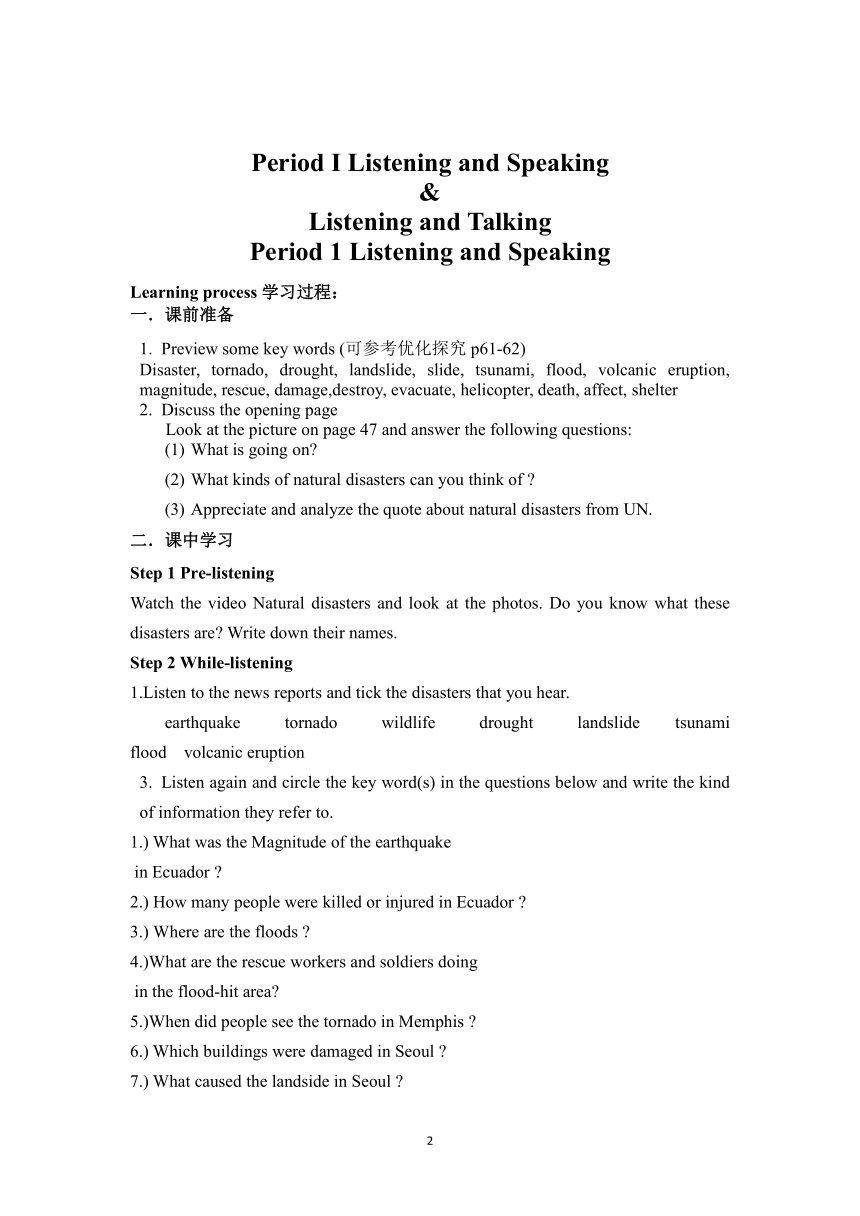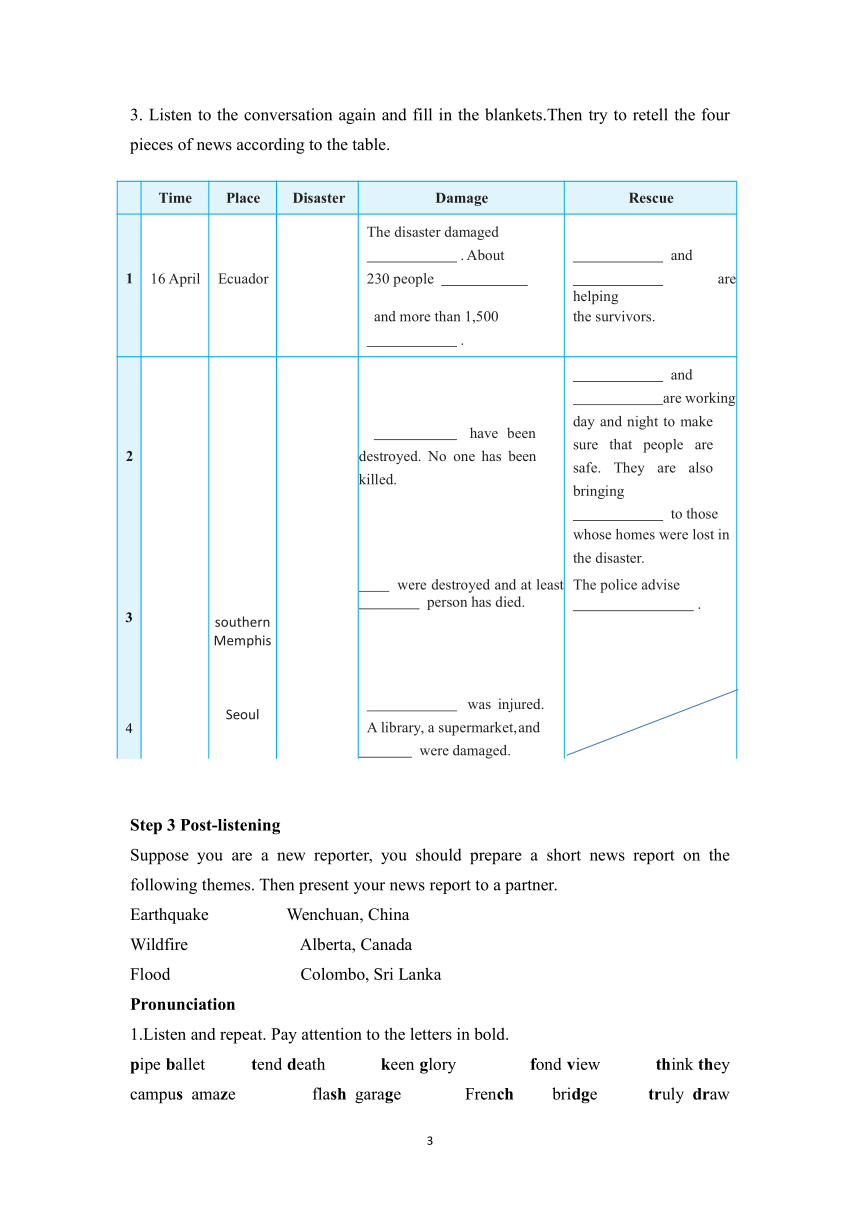人教版(2019)必修第一册Unit 4Natural disasters Period I & Period II学案
文档属性
| 名称 | 人教版(2019)必修第一册Unit 4Natural disasters Period I & Period II学案 |  | |
| 格式 | zip | ||
| 文件大小 | 77.5KB | ||
| 资源类型 | 教案 | ||
| 版本资源 | 人教版(2019) | ||
| 科目 | 英语 | ||
| 更新时间 | 2021-11-14 23:45:07 | ||
图片预览



文档简介
Unit 4 Natural Disasters
核心素养 教学目标与要求
语言能力 主题:自然灾害
语音:复习清辅音和浊辅音的发音规律,并利用这些规律准确辨音,有效记忆单词。
词汇:能正确使用下列单词和词块。disaster, drought, slide, ood, rescue, damage, destroy, death, affect, shelter, ruin, percent, brick, metal, shock, electricity, trap, bury, breathe, effort, wisdom, context, suffer, volcano, erupt, supply, typhoon, hurricane, survive, power, pipe, emergency, calm, aid, kit, crash, sweep, wave, strike, deliver, summary, effect, lengthvolcanic eruption, rise and fall, as usual, as if, come to an end, come across, in ruins, blow away, in shock, thousands of, millions of, in the open air, first aid kit, on hand, sweep away
语法:复习 that、which、who(whom)引导的定语从句;学习并掌握用 whose 引导的定语从句;能够运用关系代词引导的定语从句描述事物的具体信息。
语篇:阅读描述重大灾害的纪实性报告文学语篇,掌握该类语篇的语言特征和叙事要点, 能分析阅读语篇的文本结构。了解新闻播报应包含的基本要素和语言特征。
表达:能够简要模仿新闻播报,报道突发的自然灾害。能够运用指令性语言,介绍应对各种自然灾害的准备工作和措施。能够为重大新闻事件的专题报道编写摘要。
学习能力 能根据听力问题,预判听力内容并能提炼出关键信息,例如:数字、时间、日期、事由等。掌握在阅读中根据上下文猜测词义的策略;巩固合成词的相关知识;能运用构词法知识推测词义。能够将话题词归类,并有所拓展。
文化意识 从历史事件的角度了解国内外发生过的一些重大自然灾害,树立防灾意识和自我保护意识;能够了解和掌握一些与自然灾害相关的安全常识和防范措施。具备积极应对灾难的意识和态度,并能从多角度积极思考,学习和了解相应举措, 减轻灾害造成的物质损失和心理创伤。
思维品质 能调动已有的知识和经验,归纳、概括、整合所获信息;能按逻辑顺序组织信息; 能在实践中运用所学应对与灾难有关的困难,增强解决问题的意识和能力。
Period Ⅰ Listening and Speaking
&
Listening and Talking
Period 1 Listening and Speaking
Learning process学习过程:
1.课前准备
1. Preview some key words (可参考优化探究p61-62)
Disaster, tornado, drought, landslide, slide, tsunami, flood, volcanic eruption, magnitude, rescue, damage,destroy, evacuate, helicopter, death, affect, shelter
2. Discuss the opening page
Look at the picture on page 47 and answer the following questions:
(1) What is going on
(2) What kinds of natural disasters can you think of
2.Appreciate and analyze the quote about natural disasters from UN.
3.课中学习
Step 1 Pre-listening
Watch the video Natural disasters and look at the photos. Do you know what these disasters are Write down their names.
Step 2 While-listening
1.Listen to the news reports and tick the disasters that you hear.
earthquake tornado wildlife drought landslide tsunami flood volcanic eruption
3. Listen again and circle the key word(s) in the questions below and write the kind of information they refer to.
1.) What was the Magnitude of the earthquake
in Ecuador
2.) How many people were killed or injured in Ecuador
3.) Where are the floods
4.)What are the rescue workers and soldiers doing
in the flood-hit area
5.)When did people see the tornado in Memphis
6.) Which buildings were damaged in Seoul
7.) What caused the landside in Seoul
3. Listen to the conversation again and fill in the blankets.Then try to retell the four pieces of news according to the table.
Time Place Disaster Damage Rescue
The disaster damaged
. About and
1 16 April Ecuador 230 people are helping
and more than 1,500 the survivors.
.
and
are working
2 have been destroyed. No one has been killed. day and night to make sure that people are safe. They are also bringing to those
whose homes were lost in
the disaster.
3 southernMemphis were destroyed and at least person has died. The police advise .
4 Seoul was injured. A library, a supermarket, and were damaged.
Step 3 Post-listening
Suppose you are a new reporter, you should prepare a short news report on the following themes. Then present your news report to a partner.
Earthquake Wenchuan, China
Wildfire Alberta, Canada
Flood Colombo, Sri Lanka
Pronunciation
1.Listen and repeat. Pay attention to the letters in bold.
pipe ballet tend death keen glory fond view think they campus amaze flash garage French bridge truly draw events friends
2.Read the words aloud. Pay attention to the pronunciation of the –ed endings. Then write the words in the boxes.
Period 2 Listening and Talking
Study process学习过程:
1. Pre-listening
(1) Look at pictures about Wenchuan earthquake and brainstorm what you should do before, during and after an earthquake.
2. While-listening
(1) Listen to the conversation for the first time and finish exercise 1.
(2) Listen again and fill in the safety instructions that you hear in the conversation and then learn more safety instructions from exercise 2.
Student 1: Mrs Fors, I think you’re a hero. And Lucky is very cute. I’d like to know what we can do to prevent natural disasters.
Mrs Fors: Well, there’s no way to prevent earthquakes and storms. But if we prepare, we can keep them from becoming disasters that kill or injure people. To be ready, make a safety list of what to do, where to go, and who to contact.
Student 1: So what should we do if there’s an earthquake
Mrs Fors: “drop, cover, and hold on”. onto your hands and knees, cover your head with your hands, and from glass, windows, or anything that could fall. find cover under a desk or table. Hold on to the desk or table so it doesn’t move away from you.
Teacher: What should we do if we’re outside when an earthquake happens
Mrs Fors: an open space away from buildings, trees, or power lines.
Student 2: And what about after an earthquake
Mrs Fors: Well, if you’re trapped, use a cell phone to call or text for help. also tap on a pipe or a wall, or whistle for help. That way Lucky and I can find you!
3. Talking
(1)Work in groups. Choose a disaster and prepare a list of safety instructions.
(2)Having an emergency kit prepared is also very important. Look at the emergency supplies below. Discuss with partners what else you would add.
(3)Work in groups and make a “survival manual” for surviving the natural disaster. Then share your manual with the class.
Period Ⅱ Discovering useful structures
Learning process学习过程:
Step Ⅰ Lead in (Feel the sentence patterns)
Task 1 Guess what the sentences below describe.
1.(1)He is a player.
(2)A player changed basketball with his graveful moves and jumps
2.(1)It is one of vitamins.
(2)The vitamin can help you grow stronger.
3.(1)It is a flower.
(2)The flower is used to express love.
4. (1) It is a kind of fruit.
(2) The fruit looks like a yellow curving(弯弯的) boat.
5. (1) It is a blue planet.
(2)The only natural satellite of the planet is the moon.
Step Ⅱ Find the rules
Task 2 Observe and summarize the rules from three aspects--- structure, function and relative pronouns.
1. (1)Michael Jordan is a player. .
(2)Vitamin D is one of vitamins .
(3)A rose is a flower .
(4)A banana is a kind of fruit .
(5)The earth is a blue planet.
2. (1)Michael Jordan is a player who changed basketball with
his graceful moves and jumps.
(2)Vitamin D is one of vitamins that/which can help you grow stronger.
(3)A rose is a flower which/that is used to express love.
(4)A banana is a kind of fruit which/ that looks like a yellow curving boat.
(5)The earth is a blue planet whose only natural satellite is the moon.
Task 3 Listen to the music and underline all the attributive clauses. Then discuss how to Choose relative words with your partners.
Relative pronouns(关系代词) antecedent(sb./sth.)(先行词) component in a clause(从句中所作成分)
Step 3 Use the rules
1. Enjoy the following proverbs.
(1) God helps those who help themselves.
(2) He who laughs last laughs best.
(3) He who doesn't reach the Great Wall is not a true man.
(4) Don't cut down the tree which gives you shade(阴凉).
2. Finish activity 2 on P52.
3. Work with a partner. Take turns to ask each other about the pictures. Make sentences with restrictive relative clauses using that, which, who, whose, or whom.
Step 4 Study differences between restrictive attributive clause and non-restrictive attributive clause.
核心素养 教学目标与要求
语言能力 主题:自然灾害
语音:复习清辅音和浊辅音的发音规律,并利用这些规律准确辨音,有效记忆单词。
词汇:能正确使用下列单词和词块。disaster, drought, slide, ood, rescue, damage, destroy, death, affect, shelter, ruin, percent, brick, metal, shock, electricity, trap, bury, breathe, effort, wisdom, context, suffer, volcano, erupt, supply, typhoon, hurricane, survive, power, pipe, emergency, calm, aid, kit, crash, sweep, wave, strike, deliver, summary, effect, lengthvolcanic eruption, rise and fall, as usual, as if, come to an end, come across, in ruins, blow away, in shock, thousands of, millions of, in the open air, first aid kit, on hand, sweep away
语法:复习 that、which、who(whom)引导的定语从句;学习并掌握用 whose 引导的定语从句;能够运用关系代词引导的定语从句描述事物的具体信息。
语篇:阅读描述重大灾害的纪实性报告文学语篇,掌握该类语篇的语言特征和叙事要点, 能分析阅读语篇的文本结构。了解新闻播报应包含的基本要素和语言特征。
表达:能够简要模仿新闻播报,报道突发的自然灾害。能够运用指令性语言,介绍应对各种自然灾害的准备工作和措施。能够为重大新闻事件的专题报道编写摘要。
学习能力 能根据听力问题,预判听力内容并能提炼出关键信息,例如:数字、时间、日期、事由等。掌握在阅读中根据上下文猜测词义的策略;巩固合成词的相关知识;能运用构词法知识推测词义。能够将话题词归类,并有所拓展。
文化意识 从历史事件的角度了解国内外发生过的一些重大自然灾害,树立防灾意识和自我保护意识;能够了解和掌握一些与自然灾害相关的安全常识和防范措施。具备积极应对灾难的意识和态度,并能从多角度积极思考,学习和了解相应举措, 减轻灾害造成的物质损失和心理创伤。
思维品质 能调动已有的知识和经验,归纳、概括、整合所获信息;能按逻辑顺序组织信息; 能在实践中运用所学应对与灾难有关的困难,增强解决问题的意识和能力。
Period Ⅰ Listening and Speaking
&
Listening and Talking
Period 1 Listening and Speaking
Learning process学习过程:
1.课前准备
1. Preview some key words (可参考优化探究p61-62)
Disaster, tornado, drought, landslide, slide, tsunami, flood, volcanic eruption, magnitude, rescue, damage,destroy, evacuate, helicopter, death, affect, shelter
2. Discuss the opening page
Look at the picture on page 47 and answer the following questions:
(1) What is going on
(2) What kinds of natural disasters can you think of
2.Appreciate and analyze the quote about natural disasters from UN.
3.课中学习
Step 1 Pre-listening
Watch the video Natural disasters and look at the photos. Do you know what these disasters are Write down their names.
Step 2 While-listening
1.Listen to the news reports and tick the disasters that you hear.
earthquake tornado wildlife drought landslide tsunami flood volcanic eruption
3. Listen again and circle the key word(s) in the questions below and write the kind of information they refer to.
1.) What was the Magnitude of the earthquake
in Ecuador
2.) How many people were killed or injured in Ecuador
3.) Where are the floods
4.)What are the rescue workers and soldiers doing
in the flood-hit area
5.)When did people see the tornado in Memphis
6.) Which buildings were damaged in Seoul
7.) What caused the landside in Seoul
3. Listen to the conversation again and fill in the blankets.Then try to retell the four pieces of news according to the table.
Time Place Disaster Damage Rescue
The disaster damaged
. About and
1 16 April Ecuador 230 people are helping
and more than 1,500 the survivors.
.
and
are working
2 have been destroyed. No one has been killed. day and night to make sure that people are safe. They are also bringing to those
whose homes were lost in
the disaster.
3 southernMemphis were destroyed and at least person has died. The police advise .
4 Seoul was injured. A library, a supermarket, and were damaged.
Step 3 Post-listening
Suppose you are a new reporter, you should prepare a short news report on the following themes. Then present your news report to a partner.
Earthquake Wenchuan, China
Wildfire Alberta, Canada
Flood Colombo, Sri Lanka
Pronunciation
1.Listen and repeat. Pay attention to the letters in bold.
pipe ballet tend death keen glory fond view think they campus amaze flash garage French bridge truly draw events friends
2.Read the words aloud. Pay attention to the pronunciation of the –ed endings. Then write the words in the boxes.
Period 2 Listening and Talking
Study process学习过程:
1. Pre-listening
(1) Look at pictures about Wenchuan earthquake and brainstorm what you should do before, during and after an earthquake.
2. While-listening
(1) Listen to the conversation for the first time and finish exercise 1.
(2) Listen again and fill in the safety instructions that you hear in the conversation and then learn more safety instructions from exercise 2.
Student 1: Mrs Fors, I think you’re a hero. And Lucky is very cute. I’d like to know what we can do to prevent natural disasters.
Mrs Fors: Well, there’s no way to prevent earthquakes and storms. But if we prepare, we can keep them from becoming disasters that kill or injure people. To be ready, make a safety list of what to do, where to go, and who to contact.
Student 1: So what should we do if there’s an earthquake
Mrs Fors: “drop, cover, and hold on”. onto your hands and knees, cover your head with your hands, and from glass, windows, or anything that could fall. find cover under a desk or table. Hold on to the desk or table so it doesn’t move away from you.
Teacher: What should we do if we’re outside when an earthquake happens
Mrs Fors: an open space away from buildings, trees, or power lines.
Student 2: And what about after an earthquake
Mrs Fors: Well, if you’re trapped, use a cell phone to call or text for help. also tap on a pipe or a wall, or whistle for help. That way Lucky and I can find you!
3. Talking
(1)Work in groups. Choose a disaster and prepare a list of safety instructions.
(2)Having an emergency kit prepared is also very important. Look at the emergency supplies below. Discuss with partners what else you would add.
(3)Work in groups and make a “survival manual” for surviving the natural disaster. Then share your manual with the class.
Period Ⅱ Discovering useful structures
Learning process学习过程:
Step Ⅰ Lead in (Feel the sentence patterns)
Task 1 Guess what the sentences below describe.
1.(1)He is a player.
(2)A player changed basketball with his graveful moves and jumps
2.(1)It is one of vitamins.
(2)The vitamin can help you grow stronger.
3.(1)It is a flower.
(2)The flower is used to express love.
4. (1) It is a kind of fruit.
(2) The fruit looks like a yellow curving(弯弯的) boat.
5. (1) It is a blue planet.
(2)The only natural satellite of the planet is the moon.
Step Ⅱ Find the rules
Task 2 Observe and summarize the rules from three aspects--- structure, function and relative pronouns.
1. (1)Michael Jordan is a player. .
(2)Vitamin D is one of vitamins .
(3)A rose is a flower .
(4)A banana is a kind of fruit .
(5)The earth is a blue planet.
2. (1)Michael Jordan is a player who changed basketball with
his graceful moves and jumps.
(2)Vitamin D is one of vitamins that/which can help you grow stronger.
(3)A rose is a flower which/that is used to express love.
(4)A banana is a kind of fruit which/ that looks like a yellow curving boat.
(5)The earth is a blue planet whose only natural satellite is the moon.
Task 3 Listen to the music and underline all the attributive clauses. Then discuss how to Choose relative words with your partners.
Relative pronouns(关系代词) antecedent(sb./sth.)(先行词) component in a clause(从句中所作成分)
Step 3 Use the rules
1. Enjoy the following proverbs.
(1) God helps those who help themselves.
(2) He who laughs last laughs best.
(3) He who doesn't reach the Great Wall is not a true man.
(4) Don't cut down the tree which gives you shade(阴凉).
2. Finish activity 2 on P52.
3. Work with a partner. Take turns to ask each other about the pictures. Make sentences with restrictive relative clauses using that, which, who, whose, or whom.
Step 4 Study differences between restrictive attributive clause and non-restrictive attributive clause.
